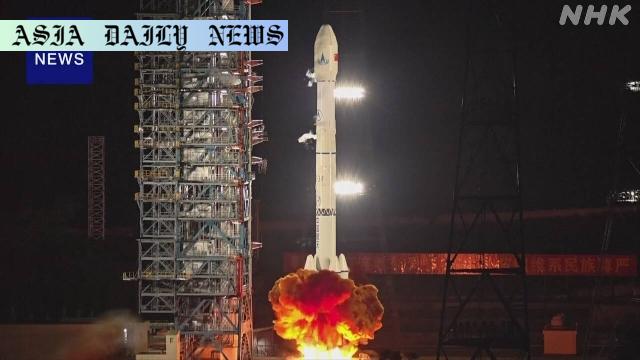Asteroid: Tianwen-2 aims to collect samples from asteroid Kamo’oalewa, transporting them 40 times the Earth-Moon distance by 2027.
- China has launched the Tianwen-2 mission to collect asteroid samples.
- It aims to retrieve samples from Kamo’oalewa and return by 2027.
- Distance to Kamo’oalewa is 40 times the Earth-Moon distance.
- Other missions like Hayabusa, Hayabusa2, and OSIRIS-REx succeeded in similar missions.

Introduction to the Tianwen-2 Mission
China has embarked on yet another ambitious space mission, marking a significant step forward in its efforts to expand its extraterrestrial exploration capabilities. On Thursday at 1:31 a.m. local time, the Tianwen-2 robotic probe was launched aboard a rocket from the Xichang Satellite Launch Center in Sichuan. This bold venture aims to retrieve samples from Kamo’oalewa, a near-Earth asteroid, and transport them safely back to Earth. This mission not only showcases China’s technological prowess but also underscores the growing competition in harvesting critical space resources.
Why the Kamo’oalewa Asteroid?
Kamo’oalewa is an intriguing target for scientific exploration. It is classified as a near-Earth asteroid that orbits the Sun and is believed to be a rocky remnant from the solar system’s early history. These celestial rocks hold vital clues about planetary formation and the building blocks of life. Additionally, studying Kamo’oalewa could help scientists better understand the behavior and trajectory of asteroids, potentially aiding in efforts to protect our planet from future asteroid impacts.
Challenges of the Tianwen-2 Mission
Despite the excitement, the Tianwen-2 mission is incredibly complex. Kamo’oalewa’s distance from Earth, measured at about 40 times the Earth-Moon distance, poses immense technical challenges. Navigating this staggering gap requires precision in trajectory planning, spacecraft communication, and accurate asteroid sampling methods. Additionally, the safe return of the collected samples to Earth by 2027 will demand reliable space technology, including a robust return capsule designed to endure atmospheric re-entry.
China’s Growing Presence in Space Exploration
The launch of Tianwen-2 emphasizes China’s growing ambitions and capabilities in the global space race. Riding on the success of its previous missions, such as the Chang’e lunar projects, this new endeavor further establishes China as a formidable player in space exploration. China is no longer just following in the footsteps of trailblazers like the United States and Japan but is carving out its own path, pushing the boundaries of what is technologically feasible.
The Legacy of Similar Missions
China’s Tianwen-2 mission adds to the legacy of pioneering asteroid-sampling efforts by other nations. Japan’s Hayabusa mission set the precedent by retrieving asteroid samples, followed by Hayabusa2, which collected and returned samples from the asteroid Ryugu. NASA’s OSIRIS-REx recently brought back samples from asteroid Bennu, furthering humanity’s understanding of these celestial objects. Tianwen-2 represents a continuation of this exploration lineage with a unique Chinese imprint.
Future Implications
By the time Tianwen-2 completes its mission around 2027, the data and samples retrieved might significantly advance our understanding of asteroids. Moreover, these missions hold potential for practical applications, such as the mining of precious metals and rare minerals from asteroids, which could revolutionize industries on Earth. Space exploration continues to evolve from a scientific endeavor to a multipurpose expedition with economic, political, and environmental implications.



Commentary
China’s Ambition in the Space Race
With the launch of Tianwen-2, China has taken a confident step into the arena of advanced extraterrestrial exploration. This mission not only highlights its technological advancements but also reflects its determination to stand shoulder-to-shoulder with other space superpowers like the United States and Japan. The world is witnessing a remarkable surge in space missions aimed at expanding humanity’s reach beyond our planet, and China’s involvement in this race adds substantial momentum to these efforts.
Complexities and Rewards of the Mission
The complexity of the Tianwen-2 mission cannot be overstated. Navigating a distance that is forty times that of the Earth-Moon gap is a Herculean challenge, demanding impeccable precision and resilience in spacecraft design. However, the potential rewards are enormous. Asteroid samples could unlock secrets about the universe’s origins, shedding light on the conditions that led to the formation of Earth and possibly other habitable worlds.
Collaborative or Competitive Space Exploration?
Another fascinating aspect of this mission is the evolving geopolitical landscape of space exploration. Although scientific collaboration has often been emphasized in space endeavors, the increasing emphasis on national supremacy and resource acquisition could lead to greater competition. China’s strides in space technology also reflect a broader push to reduce dependency on other nations while establishing itself as a global leader in science and innovation.
A Glimpse into the Future
The Tianwen-2 mission symbolizes not just a leap forward in space technology but also a vision for humanity’s future. As space exploration continues to expand, the possibilities appear boundless. From unlocking the mysteries of the cosmos to harnessing resources like rare minerals, missions like Tianwen-2 may very well chart a new course for humankind. For now, we watch with anticipation as China boldly ventures where few have gone before.